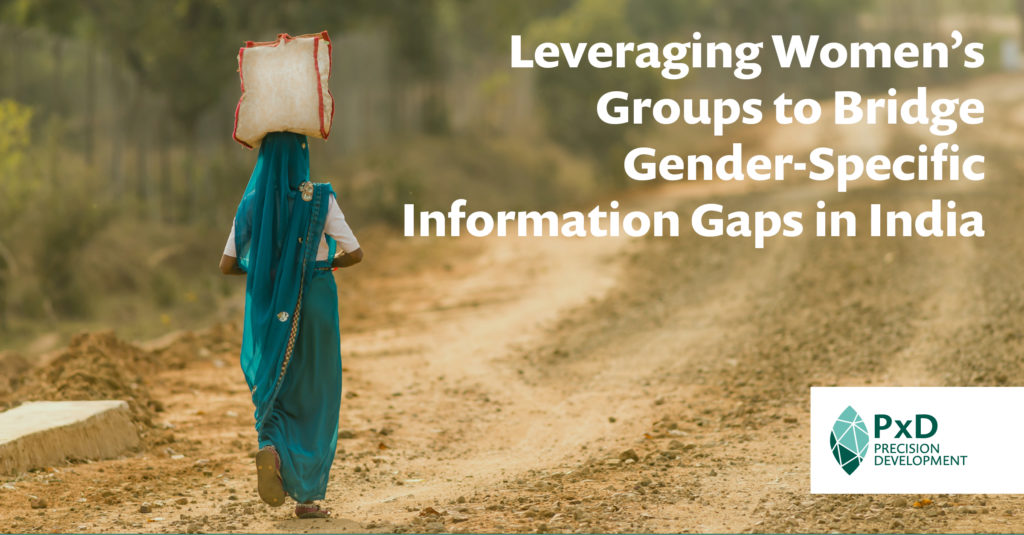Leveraging Women’s Groups to Bridge Gender-Specific Information Gaps in India
- October 15, 2021
- 10 minutes read
Vaishnavi Surendra, Post-Doctoral Researcher, and Revati Vaidya, Process and Product Innovation Associate, mark the International Day of Rural Women

At PxD, we aim to generate research and design products and services that bridge information gaps for people living in poverty. On this International Day of Rural Women, we reflect on our efforts to understand the unique challenges confronting rural women, and how PxD’s digital services can complement the work of women’s groups to empower and serve the needs of rural women.
Gendered constraints and PxD’s existing services
How does one design products and services for women that meet their unique information needs in a scalable manner?
Cultural norms and socio-economic structures often restrict women’s autonomy, mobility, and economic opportunities. When women seek financial service, healthcare, entitlements, or other livelihood-enhancing products and services, they are likely to confront a number of constraints. In addition to the barriers associated with lower levels of literacy, digital literacy, education, autonomy, or mobility that inhibit demand and restrict women’s opportunities, many rural contexts offer a limited or nonexistent supply of products and services designed to meet women’s needs.
Unsurprisingly, women’s access to and engagement with our mobile phone-based services lags that of their male peers. We estimate that 23% of our 4.4 million current users are women. To make our existing services more accessible and relevant to women, we are iterating both the content of our advisory services and ways in which users can access them. For instance, in Odisha, we recently conducted a gender-scoping survey to more effectively understand how access, time use, and division of labor vary by gender. We found that women farmer-users, inter alia, are more likely to be engaged in livestock rearing, the cultivation of horticultural crops, and the tending of kitchen gardens. As a consequence, we now provide advisory tailored to these activities to increase women’s engagement with our services.
A more complex challenge is that women often don’t have access to mobile phones. PxD’s services generally rely on users having direct access to a mobile phone to scale the dissemination of information. Gender gaps in mobile handset ownership, and cultural norms that constrain women’s access to and use of mobile phones, complicate our ability to meet the needs of women using digital information dispensed via mobile phones. In India, for example, only 38% of women own mobile phones, compared to 71% of men (Barboni et al., 2018). This gap is likely to be even larger in rural areas. We are currently exploring whether nudging male users registered on our Ama Krushi service in Odisha to switch on their mobile phone’s speaker when they receive advisory calls to facilitate greater women’s engagement. An additional line of inquiry – about which we are particularly excited – is to interact with women users via women’s groups rather than attempting to serve individual women directly.
Women’s groups in India
In many contexts, women’s groups are a popular approach to empowering women and addressing gender gaps. While the specific structure, membership, and goals of these groups vary across contexts, they generally share the following features: (i) voluntary membership; (ii) members’ contribution of time, money, or other assets; and (iii) regular face-to-face interaction among members (Biscaye et al., 2014; Dìaz-Martin et al., 2021). Women’s groups typically aim to provide members with knowledge, training, access to financial products, or access to agricultural input and output markets to facilitate improved livelihoods, financial inclusion, better literacy, and numeracy. In all instances, greater access to information has the potential to complement and enrich these offerings.
In India in particular, policymakers and practitioners increasingly view women’s groups as effective platforms capable of scaling the delivery of a range of interventions at a relatively low cost per person (Gugerty et al., 2019). Moreover, women’s groups are perceived to effectively leverage social interactions among group members to improve the impact of each intervention. In India, women come together in women’s cooperatives, farmer producer organizations, entrepreneurial marketing organizations, women’s labor collectives, microfinance groups, and most commonly in self-help groups (SHGs). Currently, there are over 7.2 million SHGs registered with the NRLM, the largest such program in the country. Areas in which women’s groups are active in expanding access and use of services and resources include access to financial services (e.g., the National Rural Livelihoods Mission (NRLM)), community health and access (e.g., the Swayam Shikshan Prayog program), and livelihood training (e.g., the National Bank for Agricultural and Rural Development’s (NABARD) Microcredit Innovation program).
Existing evidence indicates that women’s groups have been successful in facilitating greater financial inclusion (for instance, in Hoffmann et al., 2021; Banerjee et al., 2015), and some evidence suggests that their activities have had moderate effects on small business investments and profits (such as in Banerjee et al., 2015). Certain women’s groups have also successfully improved women’s political (Prillaman, 2021), economic and social empowerment (Brody et al., 2015) while others have demonstrated no such impacts (for instance, in Joshi, Palaniswamy, and Rao, 2015; Hoffmann et al., 2021). Most relevant to our use-case, in a study of 1,000 women across five states in India, Raghunathan et al. (2019) find that the provision of agricultural extension services through self-help groups improved women’s access to information and their participation in some agricultural decision-making, but that this had limited impact on agricultural practices or outcomes.1
We are confident that women’s groups in India can be effectively leveraged in ways that enable more women to access mobile phones within their groups, and engage with mobile-based services more meaningfully, than what might be possible utilizing strategies targeting individual women users. Moreover, we believe that such groups might help women access relevant information in a friendly and supportive environment since they tend to be spaces that foster and rely on camaraderie and trust. A demonstrated strength of women’s groups in India (SHGs and otherwise) is their ability to scale and bring the benefits of scale to members at the grassroots level. This is demonstrated, for example, by efforts to federate SHGs by consolidating them across villages, blocks2, and districts under the NRLM; and through the structures of SEWA, a national federation of ‘organizations of women working in the informal economy’.
Moving forward
We see women’s groups as an opportunity for PxD to reach more women with information that has the potential to improve their lives and empower them as community leaders. Examples of initiatives we are exploring are:
- Using our existing IVR-service to connect to one phone in each group during group meetings to provide technical assistance relating to agricultural practices; to facilitate training for improved access to and meaningful use of digital services (e.g., digital finance); and/or deliver nudges and encouragement to assist women with planning and management of things like individual or household finance, educational investment, or entrepreneurship. In addition to encouraging group members to share the phone, and therefore increase the reach of PxD’s digital information delivery, we also anticipate that disseminating information in groups may facilitate “social learning” among group members; for example, early adopters of PxD’s recommended agricultural practices may encourage their peers to adopt similar approaches by demonstrating positive results.
- We also see women’s groups as being effective vehicles for facilitating the aggregation of information from markets or communities through crowdsourcing, and the potential to set up a directory or repository of agglomerated information that can be accessed across user-groups. For instance, in contexts where women have limited access to information on market conditions (such as input availability, the price of inputs and of outputs, what services are available and useful, job opportunities close to their homes, etc.), a PxD service may be effective in facilitating the sharing of leads or information within and between groups during meetings. By implication, a service or platform like this is more likely to have information relevant to the needs and interests of women.
- Finally, we also see being able to complement the existing goals of many such groups and collectives by affirming women as community leaders. Part of this may entail delivering specific digital training to women’s groups or helping women become resource persons for their local communities. This might be useful in areas such as pest identification and management, or for information about community natural resources and their management. The group structure may also assist more women to access relevant information and training than if it was limited only to women with access to phones. The perception of additional leadership credentials, or the facilitation of greater leadership agency, may accrue as a consequence of women acting as “agents” who can connect with PxD’s services and deliver information to community members who lack mobile phone access.
We are excited by the potential of these channels for improving women’s economic outcomes, increasing their bargaining power, and affirming women leaders — and facilitating leadership roles — within their communities. We are actively looking for partner organizations to work with us to iterate our ideas and bring them to fruition. We look forward to keeping you posted as we proceed!
References:
- Banerjee, Abhijit, Esther Duflo, Rachel Glennerster, and Cynthia Kinnan. 2015. “The Miracle of Microfinance? Evidence from a Randomized Evaluation.” American Economic Journal: Applied Economics. 7(1): 22–53.
- Barboni, Giorgia, Erica Field, Rohini Pande, Natalia Rigol, Simone Schaner, and Charity Troyer Moore. 2018. “A Tough Call: Understanding barriers to and impacts of women’s mobile phone adoption in India.” Evidence for Policy Design: Harvard Kennedy School.
- Biscaye, Pierre, Zoe True, Christopher Clark, Katie Panhorst Harris, Leigh Anderson, and Mary Kay Gugerty. 2014. “Self-Help Groups in Development: A Review of Evidence from South Asia AndSub-Saharan Africa.” EPAR Brief 283.
- Brody, Carinne M, Thomas De Hoop, Martina Vojtkova, Martina, Ruby Warnock, Megan Dunbar, Padmini Murthy, and Shari Dworkin. 2015. “Economic Self-Help Group Programs for Improving Women’s Empowerment: A Systematic Review.” Campbell Systematic Reviews 19.
- Dìaz-Martin, Lucia, Akshara Gopalan, Eleonora Guarnieri, and Seema Jayachandran. 2021. “Greater than the Sum of the Parts? Evidence on Mechanisms Operating in Women’s Groups.” Working Paper.
- Gugerty, Mary Kay, Pierre Biscaye, and C Leigh Anderson. 2019. “Delivering development? Evidence on self-help groups as development intermediaries in South Asia and Africa.” Development Policy Review, 37(1): 129–151.
- Hoffmann, Vivian, Vijayendra Rao, Vaishnavi Surendra, and Upamanyu Datta. “Relief from Usury: Impact of a Self-Help Group Lending Program.” Journal of Development Economics, 148: 102567.
- Joshi, Shareen, Nethra Palaniswamy, and Vijayendra Rao. 2015. “Impact Evaluation Framework and Results: Odisha Rural Livelihoods Project.” The World Bank.
- Prillaman, Soledad Artiz. 2021. “Strength in Numbers: How Women’s Groups Close India’s Political Gender Gap.” American Journal of Political Science, forthcoming.
- Raghunathan, Kalyani, Samyuktha Kannan, and Agnes R. Quisumbing. 2019. “Can women’s self-help groups improve access to information, decision-making, and agricultural practices? The Indian case.” Agricultural Economics, 50: 567–580.
1 Diaz-Martin et al., 2021 provides a comprehensive overview of the evidence.
2 In India, a block is a subsidiary administrative unit below a district.

Stay Updated with Our Newsletter

Make an Impact Today


